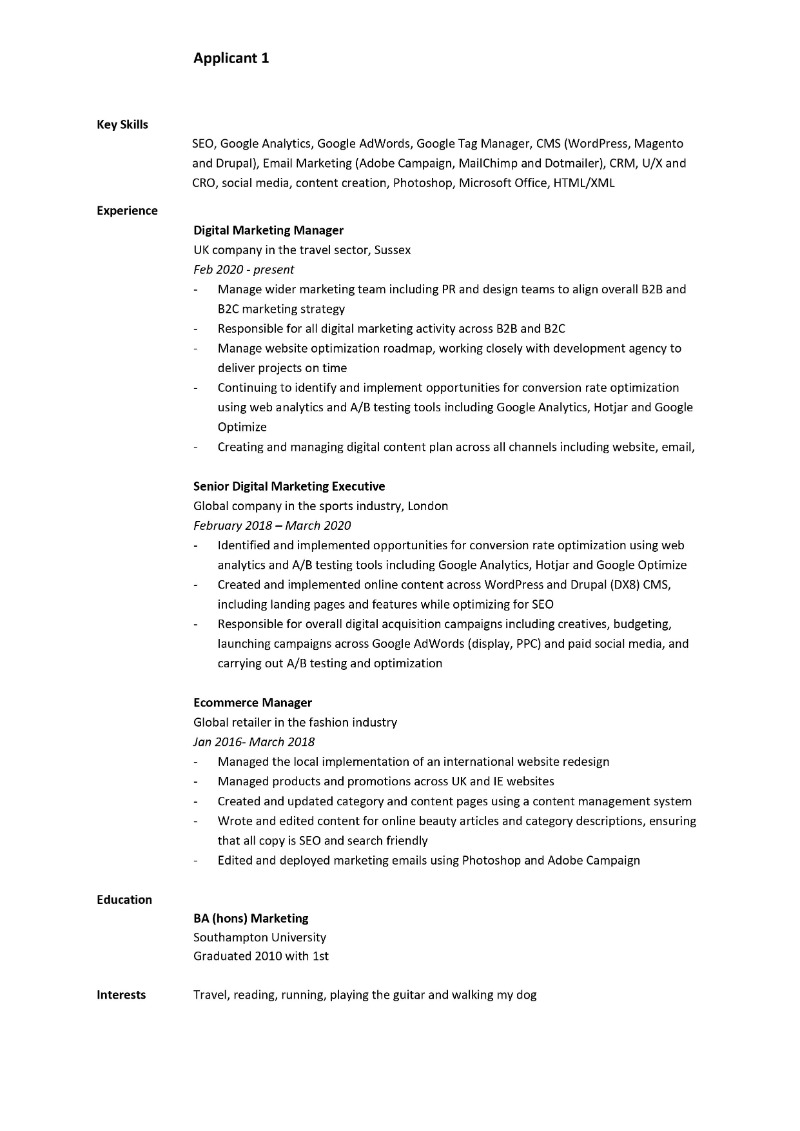
Introducing blind recruitment into your recruiting practice requires an entirely new way of thinking about who we’re hiring and why.
Blind recruitment is widely hailed as a silver bullet in diversity and inclusion, but as we’ll discuss, it’s as multi-sided as any other recruitment tool.
What is Blind Recruitment?
Blind recruitment is an equal opportunities employment practice wherein a recruiter removes cultural and demographic indicators from job applications. Removing identifiable information enables recruiters to prioritise skills-based criteria for hiring, potentially boosting diversity and inclusion.
A light touch example of an anonymised CV would include removing:
Name
Location
Ethnicity
Social media screening stage
A more thorough approach to blind recruitment could include removing:
School names
Years of work experience
Career gaps
The purpose of blind recruitment is to eliminate bias from the recruitment process. We all hold preconceived notions that can seep through during hiring, even with proper diversity training. Our biology programs us to follow unconscious cues that lead to unconscious bias. Understanding these thought pathways and using techniques such as name-blind recruitment contribute to solving these diversity barriers in modern hiring.
What is Another Word for Blind Recruitment?
Another name for Blind recruitment is anonymised recruitment. Both terms refer to the practice of removing demographic and cultural clues from a CV to avoid unnecessary bias when making a new hire.
The Benefits of Blind (or Anonymised) Recruitment
When conducted on skills-based criteria, the main benefit of anonymised hiring is typically improved team skill sets and intersectional fairness.
Specifically, in a 2022 research paper by Ramakrishnan Vivek, the researchers concluded blind hiring can "build a workforce with a higher level of skills and the ability to uplift the performance of the organisation".
What Are the Other Advantages of Blind Recruitment for Businesses?
Improved fairness in hiring
Using purely skill-based criteria for hiring ensures you hire based on a person's achievements and not on cultural factors.
Improved intersectional diversity in hiring
Typical diversity practices are often one-sided and struggle to meet intersectional needs. Even if an employer actively seeks to employ staff from different cultures, they may still discriminate, for example, against disabled people. Blind recruitment gives a black, disabled single female parent the same opportunity as a non-disabled Middle Eastern male or child-free white male.
Improve company image to attract top talent
Using blind recruitment signals to the outside world that you care about diversity and inclusion. Top talent cautious about company cultures will see your hiring practice as a green flag to apply.
Potentially shorten the hiring process
Without personal and subconscious biases to battle, you're free to make quick decisions based on facts, which can shorten the overall hiring timeline.
So that's the good of blind recruitment. But no process is ever perfect.
The Challenges and Potential Drawbacks of Blind Recruitment
As with most things in recruitment, blind recruitment also has some drawbacks. But you can mitigate these challenges with a proper strategy. Here are a few drawbacks and their solutions.
What are the other drawbacks of blind recruitment?
Reduced ability to create intentionally diverse teams
Drawback: Some industries are overwhelmingly one gender or ethnicity. As a result, employers have to actively seek diverse candidates to build diverse teams and meet diversity quotas.
Solution: Invest in industry accessibility at entry level to solve the root problem. Secondly, Invest in advertising in more diverse spaces, such as advocacy groups for your industry, to improve the percentage of diverse applicants.
Reduced ability to manage cultural clashes
Drawback: Whether it’s school and town rivalries, personal interests, or personality traits, not considering candidate backgrounds can lead to clashes in the office.
Solution: Use blind recruitment to create greater fairness in initial candidate screening. With a smaller, better-qualified group to choose from, hiring managers will have more energy to conduct chemistry interviews while consistently applying their diversity training.
First-stage only anonymity
Drawback: Face-to-face interviews are impossible to apply to blind recruitment.
Solution: Create a strict criterion on what makes a good candidate so hiring teams can focus on actively ticking boxes and not on ruling people out.
Time consuming ‘cleaning’ process
Drawback: You need someone or software to process every applicant and remove their identifiable information. The person who cleans the data needs not to be the core recruiter or HR team. If you’re dealing with more than a few applicants, this can take days, if not weeks.
Solution: Assign the proper time and resources to the process. Consider hiring a specialised external team or software to manage the process.
Blind Recruitment’s Impact on Diversity and Inclusion
Does blind recruitment improve diversity and inclusion?
Blind recruitment increases fairness and inclusion in hiring. It cannot create diversity if diversity does not already exist in the industry. For example, according to a UK Labour Force Survey, 300,000 fewer workers aged between 50 and 65 are economically active than before the pandemic. This means there is lower representation for older people in the workforce, so fewer people in this age bracket will apply for your opening.
Focusing on the fairness aspect, blind recruitment is hugely beneficial.
Research shows that employers need to create fair hiring environments. Just look at these two studies on unfair recruitment:
A CIPD research study found just 28% of employers train hiring teams on their legal obligations when recruiting; this includes laws around diversity and inclusion.
The National Bureau of Economic Research found that CVs with “white-sounding” names received nearly 50% more callbacks than those with “black-sounding” names.
Blind recruitment reduces the challenges these studies present and creates a fairer process for everyone involved.
The Blind Recruitment Process and Best Practices for Blind Recruitment
To introduce blind recruitment into your organisation, you must build transparency and fairness at every step of the process. Here’s how to get started:
Create your blind criteria. What characteristics will you remove, and which should stay for hiring accuracy? E.g. If you’re in the UK but participants need to be native French speakers, their native country is valuable information.
Educate your team on diversity and inclusion, why participants will be anonymous, and what factors they should be looking for in the correct. Clarity on the proper skill-based hiring criteria will prevent employees from looking for more instinct-based clues to make a decision.
Create a process for cleaning your applications. Ensure that it is sustainable for every application, e.g., manual cleaning may become less thorough as the person becomes tired.
Use blind recruitment for the first stage of the recruitment process. Set your hard work into action and begin collecting and reviewing anonymised CVs.
Consider diversity and inclusion training to maintain as much fairness as possible when phone or face-to-face interviews begin.
Post-hire (well done!) review your blind recruitment process and apply learnings to the next round. Remember, it’s better to learn from mistakes than to not try at the risk of failing.
What Does a Blind or Anonymised CV Look Like?
You can anonymise CVs yourself or ask applicants to submit their CV already anonymised. Here’s an example of how you can request CVs to be submitted to meet your blind recruitment criteria:

What Should an Applicant Put on a Blind or Anonymised CV?
Remember that CVs are just the first phase of a recruitment process. You can qualify candidates for essential identifiable criteria using screening questions or at the second stage interview.
Applicants should include the following information on their CV:
Relevant qualifications
Relevant experience
Relevant years of experience - potentially requested as a minimum range. For example, ask candidates to confirm they have over five years of experience but not reveal that they have additional years of experience or a career gap.
Applicants shouldn’t include:
Identifiable cultural and demographic factors such as their name, age, native country, or place of residence.
Previous careers and irrelevant work experiences
Hobbies and personal interests
Disabilities or diagnoses
Is Blind Recruitment the Future of Hiring?
More organisations are introducing blind recruitment practices and will continue to experiment in the future. Anonymous recruitment solves many of our modern-day problems with discrimination and unconscious bias while actively building better-skilled teams.
Blind recruiting puts the needs of a business first and regularly creates better-skilled teams, and in naturally diverse industries, it also contributes to more diverse teams.
We still have a way to go, however. Blind recruitment doesn’t lead to greater diversity in industries where greater societal and economic factors bar diverse groups from entering. Only if we improve equal access to education, work experience, and create diverse role models, will blind recruitment create both skilled and diverse teams.
Interested in using blind or anonymised recruitment combined with other diversity initiatives at your organisation? Contact us to discuss how we can help you.






